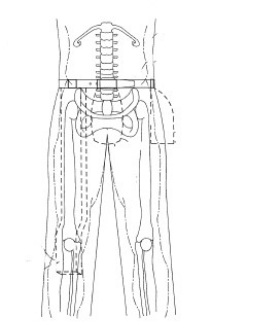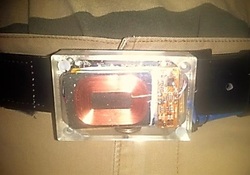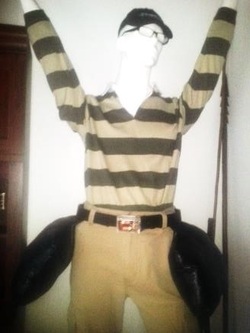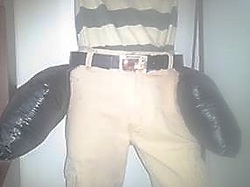Briggs Belt Systems, LLC
Improving lives with innovation
Improving lives with innovation
PROTECTIVE BELT SYSTEM

PREVENTABLE TRAGEDIES
In America, an elderly person falls every 29 minutes.
35% of people aged 65 and over fall at least once each year.
Statistically, Seniors who break a hip face a dismal future:
- 25% will die within the first 12 months of the accident
- 25% will never be able to live independently again
- 80% will never regain full mobility
THERE IS A SOLUTION
Briggs Belt Systems, LLC has developed an innovative protective device to help prevent injuries which typically occur when a person falls. Specifically, it is a Patented* Protective Belt Apparatus that is structured to cushion the body and prevent bone fractures and injury to soft tissue. Our self-contained system works by detecting the movement and angular acceleration of a person’s fall, and then deploys airbags thus providing an automatically deflating cloud-like cushion on which to softly land.
Briggs Belt Systems, LLC has developed an innovative protective device to help prevent injuries which typically occur when a person falls. Specifically, it is a Patented* Protective Belt Apparatus that is structured to cushion the body and prevent bone fractures and injury to soft tissue. Our self-contained system works by detecting the movement and angular acceleration of a person’s fall, and then deploys airbags thus providing an automatically deflating cloud-like cushion on which to softly land.
THE DEMAND

Every 11 seconds, an older adult is treated in the emergency room for a fall; every 19 minutes, an older adult dies from a fall. Millions more are permanently injured posing challenges for policymakers, caregivers, and families. The economic impact of falls is detrimental to the family, community, workplace and society. Older people who are living in nursing homes fall more often than those who are living in the community. Approximately 50% of people living in long-term care institutions fall each year, and 40% of them experience recurrent falls. The healthcare costs including surgical, nonsurgical, rehabilitation services, and pharmacological management total more than $34 Billion a year and is predicted to double by 2020. Indirect costs are losses of societal productivity for the patient and family, post-traumatic stress disorder and post-fall anxiety syndrome resulting in the need for assistance with the functions of everyday life.
The aftermath of a simple fall for the elderly or the infirm may lead to life-threatening physical, emotional and mental health issues, and the need for extensive hospitalization, rehabilitation and home care which places extensive burdens on their families, medical institutions, and insurance providers. Fall mitigation is essential and the Briggs Belt System’s Protective Belt is clearly a simple and cost-effective solution.
Protective Belt models will be tailored for various applications. For example, these might include: normal healthy living, assistive care living, hospital “at risk of fall” patients, postoperative rehabilitation, any individual forced to use crutches, canes, or walkers, military, industrial safety, people of all ages with special needs (Parkinson’s Disease and Multiple Sclerosis), persons with restrictive physical or mental disabilities, and participants in sporting and fitness activities. In areas where the risk of falling is heightened such as mines or construction sites, the BBS can reduce the consequences of workplace falls and minimize employee productivity loss, reduce worker’s compensation claims, reduce the cost to medical providers and employers, and minimize potentially life altering injuries.
The aftermath of a simple fall for the elderly or the infirm may lead to life-threatening physical, emotional and mental health issues, and the need for extensive hospitalization, rehabilitation and home care which places extensive burdens on their families, medical institutions, and insurance providers. Fall mitigation is essential and the Briggs Belt System’s Protective Belt is clearly a simple and cost-effective solution.
Protective Belt models will be tailored for various applications. For example, these might include: normal healthy living, assistive care living, hospital “at risk of fall” patients, postoperative rehabilitation, any individual forced to use crutches, canes, or walkers, military, industrial safety, people of all ages with special needs (Parkinson’s Disease and Multiple Sclerosis), persons with restrictive physical or mental disabilities, and participants in sporting and fitness activities. In areas where the risk of falling is heightened such as mines or construction sites, the BBS can reduce the consequences of workplace falls and minimize employee productivity loss, reduce worker’s compensation claims, reduce the cost to medical providers and employers, and minimize potentially life altering injuries.
THE USE

The basic model of The Protective Belt System is designed to be worn with ordinary pants. The Belt is a standard 1.25” wide belt. It will employ an easy to fasten standard belt buckle, will have the approximate thickness of a typical leather or fabric belt. It will be less than two times heavier than a standard leather belt. Its feel and appearance will be that of a typical belt and its uniqueness will not be overtly noticeable to the wearer or an observer. The Belt will be available in a variety of sizes and colors to accommodate gender, body sizes, and style.
Although we hope that the users of the Protective Belt System will never require the protection it affords, they will benefit from peace of mind and improved quality of life knowing they are protected. They will enjoy a greater freedom of movement and reduced fear of falling. and realize the improved health benefits that come from a more active lifestyle. Moreover, whether in a facility, at home, or at work, belt wearers, and their loved ones, will enjoy a sense of peace knowing that the potentially devastating consequences extending from even a minor fall are virtually eliminated from their lives.
THE METHOD
The components of the device employ proven fundamentals of physics and engineering. Its uniqueness lies in being able to differentiate movement associated with a fall (sudden acceleration for a sustained interval), as opposed to the movement of a stumble (sudden acceleration with a short duration), or sitting down (slow acceleration over a sustained interval). When sensors detect a fall, the air bags will deploy and fully inflate in 0.3 seconds, well before the wearer hits the ground. As the airbag contacts the ground, it immediately begins its rapid deflation process decreasing the speed of the fall, cushioning the landing, and preventing injury.
REQUIREMENT FOR FURTHER DEVELOPMENT

The hardware and software of the Protective Belt System are already designed and we have built working models. Currently, we are conducting extensive testing at the University of Pittsburgh’s Human Movement and Balance Laboratory to acquire the data needed to refine the programming of the device’s microprocessor, the geometry of the airbags, and the airbag deployment mechanism. This will be followed by the fabrication of “next generation” prototypes. The mass production of consumer-ready models, and marketing will be the responsibility of the buyer who purchases the technology and the intellectual property.
EXPERTS IN THEIR OWN RIGHT
Our multidisciplinary technical staff consists
of proven experts in their fields. Nine PhDs, six MDs, and other
authorities represent disciplines in Orthopedics, Biomechanics, Electronics,
Anatomy and Physiology, Physiatry, Computer and Information Science, Gerontology,
Neurobiology, Physics, Chemistry, and Biomedical, Mechanical, Electrical, and
Structural Engineering. The team collectively boasts over 70 US patents
and more than 100 worldwide patents.
*THE PROTECTIVE BELT'S INTEGRATED TECHNOLOGIES ARE PROTECTED BY:
U.S. Patent No. 9,532,611 Protective Belt Apparatus
U.S. Patent No. 9,526,278 Protective Belt Apparatus and Control Apparatus Therefore
U.S. Continuation Patent Application 15/355,192 Protective Belt Apparatus
U.S. Patent No. 9,526,278 Protective Belt Apparatus and Control Apparatus Therefore
U.S. Continuation Patent Application 15/355,192 Protective Belt Apparatus
For further information on the Protective Belt please contact:
Leonard C. Briggs, CEO
Briggs Belt Systems, LLC
Telephone: +1-571-286-6218
Email: lbriggs@briggsintl.com
Leonard C. Briggs, CEO
Briggs Belt Systems, LLC
Telephone: +1-571-286-6218
Email: lbriggs@briggsintl.com
